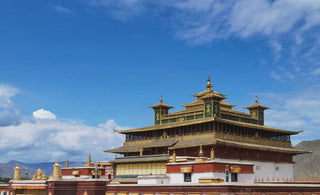
At Oriental Aesthetics, we delve deep into the heart of Tibetan culture, exploring the richness and significance of the Sho Dun Festival—a celebration that transcends time, honoring heritage and spirituality through the ages. This profound festival, also known as the "Yogurt Festival," unfolds a captivating narrative of tradition, art, and devotion.
Unveiling the Sho Dun Festival
Rooted in Centuries: The Sho Dun Festival, originating in the 7th century during the Tang Dynasty, symbolizes the offering of yogurt to monastic communities after their summer retreat. Held in the vibrant setting of Lhasa, Tibet, this grand festival marks the end of monks' seclusion and is deeply intertwined with Tibetan Buddhism's essence.
Spiritual Significance: As dusk falls upon the breathtaking landscape of Tibet, the festival commences with fervor. Elaborate rituals, vibrant performances, and the display of the intricate artistry of thangka paintings and traditional dances paint a mesmerizing picture of spirituality and devotion.
This celebration holds profound meaning in Tibetan Buddhism, marking the end of the monks' seclusion period. The meticulously orchestrated rituals and performances become a visual and auditory spectacle, captivating the senses and inviting everyone into a realm of spiritual enlightenment. Central to the Sho Dun Festival is the symbolic offering of yogurt, signifying the transition from the rainy season when monks refrain from eating green vegetables due to the possibility of harming insects living on them. The first taste of yogurt after this season holds immense spiritual significance, representing the start of a more lenient diet.
The timing of the festival aligns with the ripening of barley in the fertile valleys of Tibet. As monks return from seclusion, they partake in the initial harvest, celebrating nature's bounty and offering prayers for a plentiful harvest in the coming months.
The festival's significance extends beyond the religious realm, weaving together threads of culture, tradition, and artistry that define Tibetan heritage. At its heart, the Sho Dun Festival showcases the intricate artistry of thangka paintings, traditional dances, and mesmerizing rituals, becoming a vivid portrayal of devotion and cultural richness. It becomes an occasion where locals and visitors alike immerse themselves in the cultural fabric of Tibet, witnessing a blend of rituals, traditional performances, and vibrant colors that symbolize unity and cultural richness.
Cultural Heritage: Preserving Tradition
Artistry Unveiled: Among the festival's myriad treasures, thangka paintings reign supreme, showcasing exquisite artistry that transcends time. These intricate artworks serve as visual expressions of Tibetan Buddhist teachings, depicting deities, religious narratives, and intricate symbolism. Crafted with painstaking detail and profound spirituality, thangkas embody the essence of Tibetan culture, serving as portals to spiritual realms and cultural heritage.
An Immersive Experience through Sho Dun Festival
Cultural Reverence: At the heart of the Sho Dun Festival lies a deep reverence for Tibetan heritage. The ceremonial procession of monks, adorned in resplendent attire, heralds the beginning of a grand spectacle. The air is filled with an aura of sanctity as devotees and spectators gather, anticipating the captivating events that will unfold.
The festival is a canvas painted with vibrant hues of tradition, from the intricately designed costumes worn by performers to the symbolic gestures and rituals that honor ancient practices. The hypnotic chants and rhythmic movements of traditional dances weave a captivating narrative of devotion and cultural significance.
One of the festival's highlights is the display of thangka paintings—elaborate, detailed artworks that encapsulate the spiritual essence of Tibetan Buddhism. These intricate paintings depict deities, religious narratives, and intricate symbols, serving as a visual representation of the culture's deep-rooted spirituality.
Every stroke of the artist's brush, every intricate detail meticulously etched onto the canvas, tells a story—a story of faith, tradition, and the journey towards enlightenment. The thangka paintings not only adorn the festival grounds but also serve as portals to a world where art and spirituality intertwine.
The Sho Dun Festival offers attendees a profound opportunity to connect with Tibetan culture at its core. It's a moment to appreciate the artistry, the devotion, and the rich heritage preserved within each ritual and performance.
Oriental Aesthetics
At Oriental Aesthetics, we stand as a beacon of reverence for classical oriental art. Our platform provides a seamless experience for artists, collectors, and enthusiasts to connect, explore, and appreciate the intricate beauty of oriental art. We dedicate in preserving the cultural heritage such as thangka paintings and other classical artworks, offering professional services and fostering a community that celebrates the richness of oriental artistry.
Our commitment lies in nurturing a space where the legacy of oriental art flourishes, ensuring its preservation for generations to come.
























